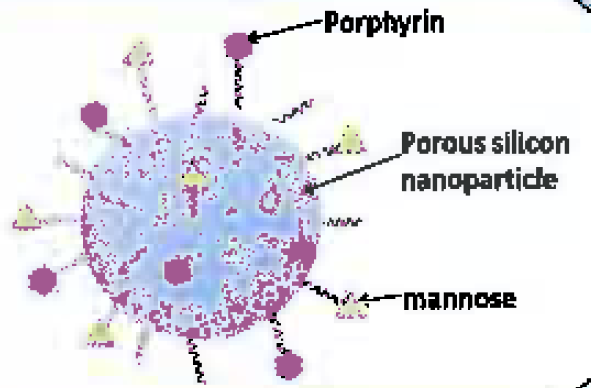Porous silicon nanoparticles functionalized for photodynamic therapy
Référence
05197-01
Mots-clés
Statut des brevets
Priority patent application n° 1000144688 filed on March 27th, 2012 entitled « Nanoparticules de silicium poreux fonctionnalisées et leurs utilisations en thérapie photodynamique »




Inventeurs
Frédérique Cunin
Statut commercial
Exclusive or non-exclusive licenses
Laboratoire
Institut Charles Gerhardt Montpellier (ICGM), a CNRS laboratory (UMR 5253) in Montpellier, France.
Description
CONTEXT
Photodynamic therapy (PDT) is an innovative way to treat cancer. This therapy is based on generation of singlet oxygen (1O2) by photosensitizers when they are irradiated with light. All sorts of nanoparticles grafted with various photosensitizers have already been studied for PDT, including silica nanoparticles, iron oxide and polymer. This technology focused on using porous silicon as photosensitizers. Porous silicon nanoparticles are known to be biocompatible and biodegradable in vivo. In addition their luminescence properties and ability to generate 1O2 when excited in the visible and near infra-red make porous silicon nanoparticles good candidates for PDT applications.
TECHNICAL DESCRIPTION
Research team succeed in functionalizing porous silicon nanoparticles by chemical grafting of two different organic compounds, in order to both target cancer cells and generate 1O2 :
– The first grafted compound is mannose. Cancer cells exhibit a lot more mannose-receptors than healthy cells, so this sugar is able to target cancer cells efficiently.
– The second grafted compound is a porphyrin, which is a photosensitizer and imaging agent.

By functionalizing porous silicon nanoparticules, efficacy of photodynamic therapy is enhanced . As a result, tumor cells accumulate nanoparticules thanks to mannose and then are killed when irradiated by near IR light.
The technology also involves a method to generate this nanoparticules.
BENEFITS
Nanoparticules are biocompatible, biodegradable, and highly specific. With this technology, PDT side effects are reduced thanks to a cell targeting. Moreover, irradiations at near infrared confer a better tissue penetration leading to improved treatment efficiency.
Advantages of PDT include the possibility of repeating treatments without cumulative toxicity (compared to radiotherapy), its cost-effectiveness, its simplicity of implementation, and its applicability to a wide range of diseases (cardiovascular, dermatological and ophthalmic diseases).
Furthermore, for patient, PDT post-operative recovery is better requiring hours or days rather than weeks.
Here, using the pSi matrix as a photoactive multifunctional host for near IR PDT ensures:
-local non-invasive treatment with enhanced selectivity towards tumor,
-early diagnostic of cancer with the tumor imaging,
-a higher efficiency of the therapy and tumor mass reduction.
Besoin de plus d'informations ?
Nous contacterTechnologies Liées
-
25.11.2015
MOF application: drug and marker carrier and targetting device
Santé / Thérapeutique 01310-01, 01310-02, 04666-01
-
31.03.2015
Protein involved in DNA replication, and modulation of its activity
Santé / Thérapeutique, Diagnostic médical 06081-01
-
16.09.2014
MOF application: gas of biological interest releasing device
Santé / Thérapeutique 01741-01